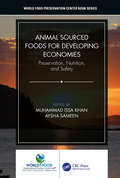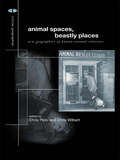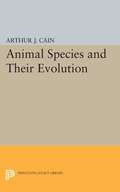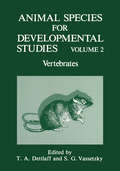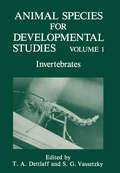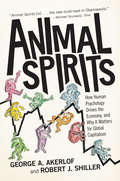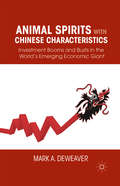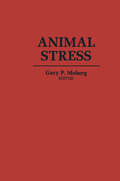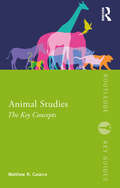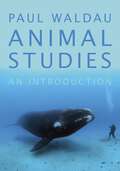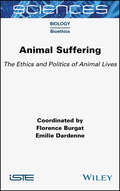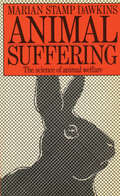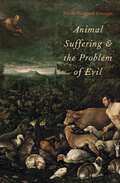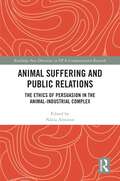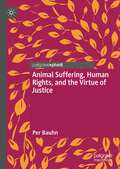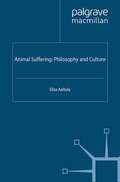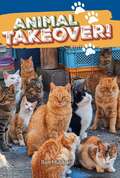- Table View
- List View
Animal Sourced Foods for Developing Economies: Preservation, Nutrition, and Safety (World Food Preservation Center Book Series)
by Muhammad Issa Khan Aysha SameenAnimal products are good source of disposable income for many small farmers in developing countries. In fact, livestock are often the most important cash crop in many small holder mixed farming systems. Livestock ownership currently supports and sustains the livelihoods of rural poor, who depend partially or fully on livestock for their income and/or subsistence. Human population growth, increasing urbanization and rising incomes are predicted to double the demand for, and production of, livestock products in the developing countries over the next twenty years. The future holds great opportunities for animal production in developing countries. Animal Sourced Foods for Developing Economies addresses five major issues: 1) Food safety and nutritional status in developing world; 2) the contribution of animal origin foods in human health; 3) Production processes of animal foods along with their preservation strategies; 4) functional outcomes of animal derived foods; and finally, 5) strategies, issues and polices to promote animal origin food consumption. Animal sourced food contain high biological value protein and important micronutrients required for optimal body functioning but are regarded as sources of fat that contribute to the intake of total and saturated fatty acids in diet. The quality of protein source has a direct influence on protein digestibility, as a greater proportion of higher quality proteins is absorbed and becomes available for bodily functions. Animal foods has high quantity and quality of protein that includes a full complement of the essential amino acids in the right proportion. Land availability limits the expansion of livestock numbers in extensive production systems in most regions, and the bulk of the increase in livestock production will come from increased productivity through intensification and a wider adoption of existing and new production and marketing technologies. The significant changes in the global consumption and demand for animal source foods, along with increasing pressures on resources, are having some important implications for the principal production systems. In this book, contributors critically analyze and describe different aspects of animal’s origin foods. Each chapter is dedicated to a specific type of food from animal source, its nutritional significance, preservation techniques, processed products, safety and quality aspects on conceptual framework. Special attention is given to explain current food safety scenario in developing countries and contribution of animal derived food in their dietary intake. Existing challenges regarding production, processing and promotion of animal’s origin foods are also addressed with possible solutions and strengthening approaches.
Animal Sourced Foods for Developing Economies: Preservation, Nutrition, and Safety (World Food Preservation Center Book Series)
by Muhammad Issa Khan Aysha SameenAnimal products are good source of disposable income for many small farmers in developing countries. In fact, livestock are often the most important cash crop in many small holder mixed farming systems. Livestock ownership currently supports and sustains the livelihoods of rural poor, who depend partially or fully on livestock for their income and/or subsistence. Human population growth, increasing urbanization and rising incomes are predicted to double the demand for, and production of, livestock products in the developing countries over the next twenty years. The future holds great opportunities for animal production in developing countries. Animal Sourced Foods for Developing Economies addresses five major issues: 1) Food safety and nutritional status in developing world; 2) the contribution of animal origin foods in human health; 3) Production processes of animal foods along with their preservation strategies; 4) functional outcomes of animal derived foods; and finally, 5) strategies, issues and polices to promote animal origin food consumption. Animal sourced food contain high biological value protein and important micronutrients required for optimal body functioning but are regarded as sources of fat that contribute to the intake of total and saturated fatty acids in diet. The quality of protein source has a direct influence on protein digestibility, as a greater proportion of higher quality proteins is absorbed and becomes available for bodily functions. Animal foods has high quantity and quality of protein that includes a full complement of the essential amino acids in the right proportion. Land availability limits the expansion of livestock numbers in extensive production systems in most regions, and the bulk of the increase in livestock production will come from increased productivity through intensification and a wider adoption of existing and new production and marketing technologies. The significant changes in the global consumption and demand for animal source foods, along with increasing pressures on resources, are having some important implications for the principal production systems. In this book, contributors critically analyze and describe different aspects of animal’s origin foods. Each chapter is dedicated to a specific type of food from animal source, its nutritional significance, preservation techniques, processed products, safety and quality aspects on conceptual framework. Special attention is given to explain current food safety scenario in developing countries and contribution of animal derived food in their dietary intake. Existing challenges regarding production, processing and promotion of animal’s origin foods are also addressed with possible solutions and strengthening approaches.
Animal Spaces, Beastly Places (Critical Geographies)
by Chris Philo Chris WilbertAnimal Spaces, Beastly Places examines how animals interact and relate with people in different ways. Using a comprehensive range of examples, which include feral cats and wild wolves, to domestic animals and intensively farmed cattle, the contributors explore the complex relations in which humans and non-human animals are mixed together. Our emotions involving animals range from those of love and compassion to untold cruelty, force, violence and power. As humans we have placed different animals into different categories, according to some notion of species, usefulness, domesticity or wildness. As a result of these varying and often contested orderings, animals are assigned to particular places and spaces. Animal Spaces, Beastly Places shows us that there are many exceptions and variations on the spatiality of human-animal spatial orderings, within and across cultures, and over time. It develops new ways of thinking about human animal interactions and encourages us to find better ways for humans and animals to live together.
Animal Spaces, Beastly Places (Critical Geographies)
by Chris Philo Chris WilbertAnimal Spaces, Beastly Places examines how animals interact and relate with people in different ways. Using a comprehensive range of examples, which include feral cats and wild wolves, to domestic animals and intensively farmed cattle, the contributors explore the complex relations in which humans and non-human animals are mixed together. Our emotions involving animals range from those of love and compassion to untold cruelty, force, violence and power. As humans we have placed different animals into different categories, according to some notion of species, usefulness, domesticity or wildness. As a result of these varying and often contested orderings, animals are assigned to particular places and spaces. Animal Spaces, Beastly Places shows us that there are many exceptions and variations on the spatiality of human-animal spatial orderings, within and across cultures, and over time. It develops new ways of thinking about human animal interactions and encourages us to find better ways for humans and animals to live together.
Animal Species and Their Evolution (PDF)
by Arthur J. CainLong before Charles Darwin undertook his first voyage, animal taxonomists had begun the scientific classification of animals, plants, and minerals. In the mid-1950s, taxonomist A. J. Cain summarized the state of knowledge about the structure of the living world in his major book Animal Species and Their Evolution. His work remains remarkably current today. Here Cain explains each of the terms by which scientists now classify all animals--from species through genus, family, order, class, and phylum.The work of the modern taxonomist is dependent on the work of paleontologists, field biologists, ecologists, and other specialists who help piece together the puzzle of nature. This seminal text will interest students in each of these areas. It will also appeal to historians of science and to all amateur scientists with an interest in the animal kingdom.Originally published in 1993.The Princeton Legacy Library uses the latest print-on-demand technology to again make available previously out-of-print books from the distinguished backlist of Princeton University Press. These editions preserve the original texts of these important books while presenting them in durable paperback and hardcover editions. The goal of the Princeton Legacy Library is to vastly increase access to the rich scholarly heritage found in the thousands of books published by Princeton University Press since its founding in 1905.
Animal Species For Developmental Studies: Vertebrates
by T. A. Dettlaff Sergei G. VassetzkyThis volume is a revised and augmented edition of part of the book Ob"ekty Biologii Razvitiya (Animal Species for Developmental Studies) published in Rus sian in 1975 in the series of monographs Problemy Biologii Razvitiya (Problems of Developmental Biology) by Nauka Publishers, Moscow. That book described the development of organisms most frequently used in developmental biology studies. Data were provided for 22 animal species, belonging to different taxa, from protists to mammals. For the English edition we decided to divide the original book into two parts dealing with vertebrates and invertebrates, respectively. This volume deals with vertebrate species. When choosing these species, their advantages for laboratory studies, infonnation available, and availability for experimentation in the USSR and in Europe were taken into account. This geographical criterion explains the absence in the book of a number of species widely used in the laboratories of the USA, Japan, and other countries, such as Rana pipiens, Cynops pyrrhogaster, and others. Besides the classical laboratory animals, some fish have been described since the study of the mechanisms of their development and attempts to control their on togenesis are of immediate value and the results obtained can be tested on the mass material. A study of the development of laboratory mammals is of special interest since current problems of modern medicine and veterinary sciences are tackled using these animals.
Animal Species for Developmental Studies: Volume 1 Invertebrates
by T. A. Dettlaff Sergei G. VassetzkyThis volume comprises normal tables (description of normal development) for protozoa and invertebrates widely used in developmental biology studies. The species chosen reflect their advantages for laboratory studies, the information avail able, and their availability for experimentation. Chapter 11, which contains the normal tables for the starfish Asterina pectinifera, was written specially for this edi tion, which is the invertebrate section of the revised and augmented translation of Ob"ekty Biologii Razvitiya published in Russian in 1975 as a volume in the series of monographs Problemy Biologii Razyitiya (Problems of Developmental Biology) by Nauka Publishers, Moscow. The description of every species is preceded by an introduction in which the advantages of working with the particular animal are stated and the problems stud ied (with the main references) are outlined. Data are also provided on its taxonomic status and distribution of the animal, and conditions of keeping the adult animals in laboratory. Methods of obtaining gametes, methods of artificial fertilization, meth ods of rearing embryos and larvae, and tables of normal development are also given.
Animal Spirits: How Human Psychology Drives the Economy, and Why It Matters for Global Capitalism
by Robert J. Shiller George A. AkerlofThe global financial crisis has made it painfully clear that powerful psychological forces are imperiling the wealth of nations today. From blind faith in ever-rising housing prices to plummeting confidence in capital markets, "animal spirits" are driving financial events worldwide. In this book, acclaimed economists George Akerlof and Robert Shiller challenge the economic wisdom that got us into this mess, and put forward a bold new vision that will transform economics and restore prosperity. Akerlof and Shiller reassert the necessity of an active government role in economic policymaking by recovering the idea of animal spirits, a term John Maynard Keynes used to describe the gloom and despondence that led to the Great Depression and the changing psychology that accompanied recovery. Like Keynes, Akerlof and Shiller know that managing these animal spirits requires the steady hand of government--simply allowing markets to work won't do it. In rebuilding the case for a more robust, behaviorally informed Keynesianism, they detail the most pervasive effects of animal spirits in contemporary economic life--such as confidence, fear, bad faith, corruption, a concern for fairness, and the stories we tell ourselves about our economic fortunes--and show how Reaganomics, Thatcherism, and the rational expectations revolution failed to account for them. Animal Spirits offers a road map for reversing the financial misfortunes besetting us today. Read it and learn how leaders can channel animal spirits--the powerful forces of human psychology that are afoot in the world economy today. In a new preface, they describe why our economic troubles may linger for some time--unless we are prepared to take further, decisive action.
Animal Spirits: How Human Psychology Drives the Economy, and Why It Matters for Global Capitalism (PDF)
by Robert J. Shiller George A. AkerlofThe global financial crisis has made it painfully clear that powerful psychological forces are imperiling the wealth of nations today. From blind faith in ever-rising housing prices to plummeting confidence in capital markets, "animal spirits" are driving financial events worldwide. In this book, acclaimed economists George Akerlof and Robert Shiller challenge the economic wisdom that got us into this mess, and put forward a bold new vision that will transform economics and restore prosperity. Akerlof and Shiller reassert the necessity of an active government role in economic policymaking by recovering the idea of animal spirits, a term John Maynard Keynes used to describe the gloom and despondence that led to the Great Depression and the changing psychology that accompanied recovery. Like Keynes, Akerlof and Shiller know that managing these animal spirits requires the steady hand of government--simply allowing markets to work won't do it. In rebuilding the case for a more robust, behaviorally informed Keynesianism, they detail the most pervasive effects of animal spirits in contemporary economic life--such as confidence, fear, bad faith, corruption, a concern for fairness, and the stories we tell ourselves about our economic fortunes--and show how Reaganomics, Thatcherism, and the rational expectations revolution failed to account for them. Animal Spirits offers a road map for reversing the financial misfortunes besetting us today. Read it and learn how leaders can channel animal spirits--the powerful forces of human psychology that are afoot in the world economy today. In a new preface, they describe why our economic troubles may linger for some time--unless we are prepared to take further, decisive action.
Animal Spirits with Chinese Characteristics: Investment Booms and Busts in the World’s Emerging Economic Giant
by M. DeWeaverWill China eventually be able to eliminate its socialist animal spirits? Highlighting the importance of China's investment booms and busts for both the Chinese and the world economy, Animal Spirits with Chinese Characteristics describes the origins and evolution of the investment cycle during the command economy period.
Animal Stress
by Gary P. MobergBased on a recent symposium that brought together experts in behavior, nutrition, physiology, immunology, and human and animal medicine, this volume presents an up-to-date discussion of the problems and methods of studying animal stress today. Section one reviews the evolutionary and ontogenetic determinants of animal suffering and the assessment of well-being. The second section examines biological responses to stress and methods of monitoring stress in animals. Section three shows how stress can threaten animal health, disrupt normal reproduction, and influence growth and metabolism. The final section relates the importance of animal stress to developing guidelines on the use of animals in scientific research. This is an invaluable reference for exploring these complex responses
Animal Studies: The Key Concepts (Routledge Key Guides)
by Matthew R. CalarcoPrefaced with a brief introduction to the field of animal studies, the text explores the key influential terms, topics and debates which have had a major impact on the field, and that students are most likely to encounter in their animal studies classes. Animal Studies provides a guide to key concepts in the burgeoning interdisciplinary field of animal studies, laid out in A-Z format. While Human–Animal Studies and Critical Animal Studies are the main frameworks that inform the bulk of the writings in animal studies and the key concepts discussed in the volume, other approaches such as anthrozoology and cognitive ethology are also explored. The entries in the volume attend to the differences in ongoing debates among scholars and activists, showing that what is commonly called “animal studies” is far from a unified body of work. A full bibliography of sources is included at the end of the book, along with an extensive index. The book will be a valuable guide to undergraduate and postgraduate students in geography, philosophy, sociology, anthropology, women’s studies, and other related disciplines. Seasoned researchers will find the book helpful, when researching topics outside of their specialization. Outside of academia, it will be of interest to activists, as well as professional organizations.
Animal Studies: The Key Concepts (Routledge Key Guides)
by Matthew R. CalarcoPrefaced with a brief introduction to the field of animal studies, the text explores the key influential terms, topics and debates which have had a major impact on the field, and that students are most likely to encounter in their animal studies classes. Animal Studies provides a guide to key concepts in the burgeoning interdisciplinary field of animal studies, laid out in A-Z format. While Human–Animal Studies and Critical Animal Studies are the main frameworks that inform the bulk of the writings in animal studies and the key concepts discussed in the volume, other approaches such as anthrozoology and cognitive ethology are also explored. The entries in the volume attend to the differences in ongoing debates among scholars and activists, showing that what is commonly called “animal studies” is far from a unified body of work. A full bibliography of sources is included at the end of the book, along with an extensive index. The book will be a valuable guide to undergraduate and postgraduate students in geography, philosophy, sociology, anthropology, women’s studies, and other related disciplines. Seasoned researchers will find the book helpful, when researching topics outside of their specialization. Outside of academia, it will be of interest to activists, as well as professional organizations.
Animal Studies: An Introduction
by Paul WaldauAnimal studies is a growing interdisciplinary field that incorporates scholarship from public policy, sociology, religion, philosophy, and many other areas. In essence, it seeks to understand how humans study and conceive of other-than-human animals, and how these conceptions have changed over time, across cultures, and across different ways of thinking. This interdisciplinary introduction to the field boldly and creatively foregrounds the realities of nonhuman animals, as well as the imaginative and ethical faculties that humans must engage to consider our intersection with living beings outside of our species. It also compellingly demonstrates that the breadth and depth of thinking and humility needed to grasp the human-nonhuman intersection has the potential to expand the dualism that currently divides the sciences and humanities. As the first holistic survey of the field, Animal Studies is essential reading for any student of human-animal relationships and for all people who care about the role nonhuman animals play in our society.
Animal Studies: An Introduction
by Paul WaldauAnimal studies is a growing interdisciplinary field that incorporates scholarship from public policy, sociology, religion, philosophy, and many other areas. In essence, it seeks to understand how humans study and conceive of other-than-human animals, and how these conceptions have changed over time, across cultures, and across different ways of thinking. This interdisciplinary introduction to the field boldly and creatively foregrounds the realities of nonhuman animals, as well as the imaginative and ethical faculties that humans must engage to consider our intersection with living beings outside of our species. It also compellingly demonstrates that the breadth and depth of thinking and humility needed to grasp the human-nonhuman intersection has the potential to expand the dualism that currently divides the sciences and humanities. As the first holistic survey of the field, Animal Studies is essential reading for any student of human-animal relationships and for all people who care about the role nonhuman animals play in our society.
Animal Suffering: The Ethics and Politics of Animal Lives
by Florence Burgat Emilie DardenneThis interdisciplinary volume deals with the most painful situations encountered by animals in the wild or under human guardianship. It seeks to illustrate some remarkable cases and present a general picture of the commodification of animals. This volume starts with an exploration of the capture of animals intended for European zoological parks, the treatment of animals in South Korea, pig farming in China and animal testing in Europe. It goes on to explore animal politics, with a focus on Europe. The moral problems posed by the different types of harm caused to animals are then approached from the vantage point of moral philosophy. Finally, the points of view of veterinary sciences and applied ethics related to animal emotions, suffering and death complete the picture.
Animal Suffering: The Ethics and Politics of Animal Lives
by Florence Burgat Emilie DardenneThis interdisciplinary volume deals with the most painful situations encountered by animals in the wild or under human guardianship. It seeks to illustrate some remarkable cases and present a general picture of the commodification of animals. This volume starts with an exploration of the capture of animals intended for European zoological parks, the treatment of animals in South Korea, pig farming in China and animal testing in Europe. It goes on to explore animal politics, with a focus on Europe. The moral problems posed by the different types of harm caused to animals are then approached from the vantage point of moral philosophy. Finally, the points of view of veterinary sciences and applied ethics related to animal emotions, suffering and death complete the picture.
Animal Suffering: The Science of Animal Welfare
by Marian DawkinsI wrote this book because I believe that the welfare of animals is a very important subject but one about which there is a of confusion and muddled thinking. I wanted to great deal write a book which straightened out some of the confusion by looking in detail at one particular problem: how to recognize animal suffering. The book is written for anyone interested in animals and the controversies over how human beings should treat them. I have tried to convince people who might otherwise feel that science had only a rather sinister connection with animal welfare that the scientific study of animal suffering has, in fact, a major and positive contribution to make. It can give us an insight into what animals experience and this, in tum, may help us to alleviate their suffering. At the same time, I have tried to write a book that will be of at least some use to scientists. The chapters which follow pro vide an outline of the biological approach to animal welfare. I have also attempted to show sceptics that it is possible to study animal suffering without sacrificing standards of scien tific procedure. Perhaps some may even come to share my belief that the study of the subjective experiences of animals is one of the most fascinating areas in the whole of biology, as well as being of great practical and ethical importance.
Animal Suffering and Public Relations: The Ethics of Persuasion in the Animal-Industrial Complex (Routledge New Directions in PR & Communication Research)
by Núria AlmironAnimal Suffering and Public Relations conducts an ethical assessment of public relations, mainly persuasive communication and lobbying, as deployed by some of the main businesses involved in the animal-industrial complex—the industries participating in the systematic and institutionalised exploitation of animals.Society has been experiencing a growing ethical concern regarding humans’ (ab)use of other animals. This is a trend first promoted by the development of animal ethics—which claims any sentient being, because of sentience, deserves moral consideration—and more recently by other approaches from the social sciences, including critical animal studies. In this volume, we aim to start an entirely unaddressed discussion within the field of public relations: The need to problematise the ethics of persuasion when nonhuman animal suffering is involved, particularly the impact of persuasion and lobbying on compassion towards other animals in the cases of food, experimentation, entertainment, and environmental management. This book provides an interdisciplinary, theoretical discussion illustrated with international case studies from experts in strategic communication, public relations, lobbying and advocacy, animal ethics, philosophy of law, political philosophy, and social psychology.This unique book merges the fields of critical public relations, animal ethics, and critical animal studies and will be of direct appeal to a wide range of researchers, academics, and doctoral students across related fields.
Animal Suffering and Public Relations: The Ethics of Persuasion in the Animal-Industrial Complex (Routledge New Directions in PR & Communication Research)
Animal Suffering and Public Relations conducts an ethical assessment of public relations, mainly persuasive communication and lobbying, as deployed by some of the main businesses involved in the animal-industrial complex—the industries participating in the systematic and institutionalised exploitation of animals.Society has been experiencing a growing ethical concern regarding humans’ (ab)use of other animals. This is a trend first promoted by the development of animal ethics—which claims any sentient being, because of sentience, deserves moral consideration—and more recently by other approaches from the social sciences, including critical animal studies. In this volume, we aim to start an entirely unaddressed discussion within the field of public relations: The need to problematise the ethics of persuasion when nonhuman animal suffering is involved, particularly the impact of persuasion and lobbying on compassion towards other animals in the cases of food, experimentation, entertainment, and environmental management. This book provides an interdisciplinary, theoretical discussion illustrated with international case studies from experts in strategic communication, public relations, lobbying and advocacy, animal ethics, philosophy of law, political philosophy, and social psychology.This unique book merges the fields of critical public relations, animal ethics, and critical animal studies and will be of direct appeal to a wide range of researchers, academics, and doctoral students across related fields.
Animal Suffering and the Problem of Evil
by Nicola Hoggard CreeganNicola Hoggard Creegan offers a compelling examination of the problem of evil in the context of animal suffering, disease, and extinction and the violence of the evolutionary process. Using the parable of the wheat and the tares as a hermeneutical lens for understanding the tragedy and beauty of evolutionary history, she shows how evolutionary theory has deconstructed the primary theodicy of historic Christianity-the Adamic fall-while scientific research on animals has increased appreciation of animal sentience and capacity for suffering. Animal Suffering and the Problem of Evil responds to this new theodic challenge. Hoggard Creegan argues that nature can be understood as an interrelated mix of the perfect and the corrupted: the wheat and the tares. At times the good is glimpsed, but never easily or unequivocally. She then argues that humans are not to blame for all evil because so much evil preceded human becoming. Finally, she demonstrates that faith requires a confidence in the visibility of the work of God in nature, regardless of how infinitely subtle and almost hidden it is, affirming that there are ways of perceiving the evolutionary process beyond that "nature is red in tooth and claw."
Animal Suffering: Philosophy and Culture (The Palgrave Macmillan Animal Ethics Series)
by E. AaltolaExploring how animal suffering is made meaningful within Western ramifications, the book investigates themes such as skepticism concerning non-human experience, cultural roots of compassion, and contemporary approaches to animal ethics. At its center is the pivotal question: What is the moral significance of animal suffering?
